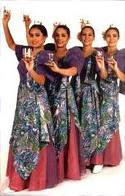Binasuan
- Originated in Pangasinan Province “meaning with
the use of drinking glasses”, this vibrant dance basically shows off
balancing skill of the performers. Glasses filled with rice wine are
placed on the head and on each hand carefully maneuvered with graceful
movements. This dance is common in weddings, fiestas and special
occasions.
Rigodon
- Originated from Spain, this dance is commonly
performed at formal affairs like inaugural balls where prominent members
of the government participate and enjoy.
Pandanggo sa Ilaw
- The word pandanggo comes from the Spanish dance
“fandango”characterized with lively steps and clapping while following a
varying ¾ beat. Pandanggo requires excellent balancing skill to
maintain the stability of three tinggoy, or oil lamps, placed on head
and at the back of each hand. This famous dance of grace and balance
originated from Lubang Island, Mindoro.
Sublian
- The term “subli” is from two tagalog words
“subsub” meaning falling on head and “bali”, which means broken. Hence,
the dancers appear to be lame and crooked throughout the dance. This
version is originally a ritual dance of the natives of Bauan, Batangas,
which is shown during fiestas as a ceremonial worship dance to the
town’s icon, the holy cross.
Kuratsa
- Commonly performed during festivals in Bohol and
other Visayan towns, this dance portrays a young playful couple’s
attempt to get each other’s attention. It is performed in a moderate
waltz style.
Itik-itik
- According to history of this dance, a young
woman named Kanang (short for Cayetana) happened to be the best
performer in the province of Surigao del Norte. At one baptismal
reception, she was asked to dance the Sibay, and began improvising her
steps in the middle of her performance imitating the movements of an
“itik”, a duck, as it walks with choppy steps and splashes water on its
back while attracting its mate. Because of its unusual steps and
fascinating interpretation, the audience began imitating her.
Tinikling
- Tinnikling is considered the national folkdance
with a pair of dancers hopping between two bamboo poles held just above
the ground and struck together in time to music. Originated from Leyte
Province, this dance is in fact a mimic movement of “tikling birds”
hopping over trees, grass stems or over bamboo traps set by farmers.
Dancers perform this dance with remarkable grace and speed jumping
between bamboo poles.
Maglalatik
- Originally performed in Binan, Laguna as a
mock-war dance that demonstrates a fight between the Moros and the
Christians over the prized latik or coconut meat during the Spanish
rule, this dance is also shown to pay tribute to the town’s patron
saint, San Isidro Labrador. It has a four-part performance such as the
palipasan and the baligtaran showing the intense battle, the paseo and
the escaramusa- the reconciliation. Moro dancers wear read trousers
while the Christian dancers show up in blue. All dancers are male ; with
harnesses of coconut shells attached on their chests, backs, thighs and
hips.
Maria Clara
- Maria Clara is the main female character in Jose
Rizal’s Noli Me Tangere -a literary piece that features the colonial
situation of the Filipinos during the Spanish regime. She was
characterized as a Filipina woman of virtue and nobility. This dance is a
mix of Spanish gracefulness and customized native props, such as bamboo
castanets and Asian fan. Female dancers wear Maria Clara dress that
typifies the European style, while men are in barong tagalog, a
traditional Filipino embroidered long-sleeve shirt made of pineapple
fiber.
Cariñosa
- Cariñosa is a word that describes an
affectionate, friendly and lovable woman. This dance is performed in
flirtatious manner with fans and handkerchiefs to assist the dancers’
hide-and-seek movements.
La Jota Manileña
- It is a dance named after the capital city of
the Philippines, Manila, where an adaptation of Castilian Jota afloats
with the clacking of bamboo castanets played by the dancers themselves.
The costume and the graceful movements of the performers noticeably
inspired by Spanish Culture.
Sakuting
- Originated in Abra, this dance interprets a mock
fight between Ilokano Christians and non- Christians with training
sticks as props. It is traditionally performed during Christmas at the
town plaza or from house-to-house as a caroling show. As a return, the
dancers receive presents or money locally known as “aguinaldo”.
Pantomina
- Meaning "Dance of the Doves", this dance is the
highlight of Sorsogon’s Kasanggayahan Festival every third week of
October. Groups of participants, mainly elderly in colourful costumes,
dance to the tune of Pantomina song. It is a courtship dance originated
from immitating the courtship and lovemaking of doves that then showed
during the dance where men attempt to please the women.













No comments:
Post a Comment